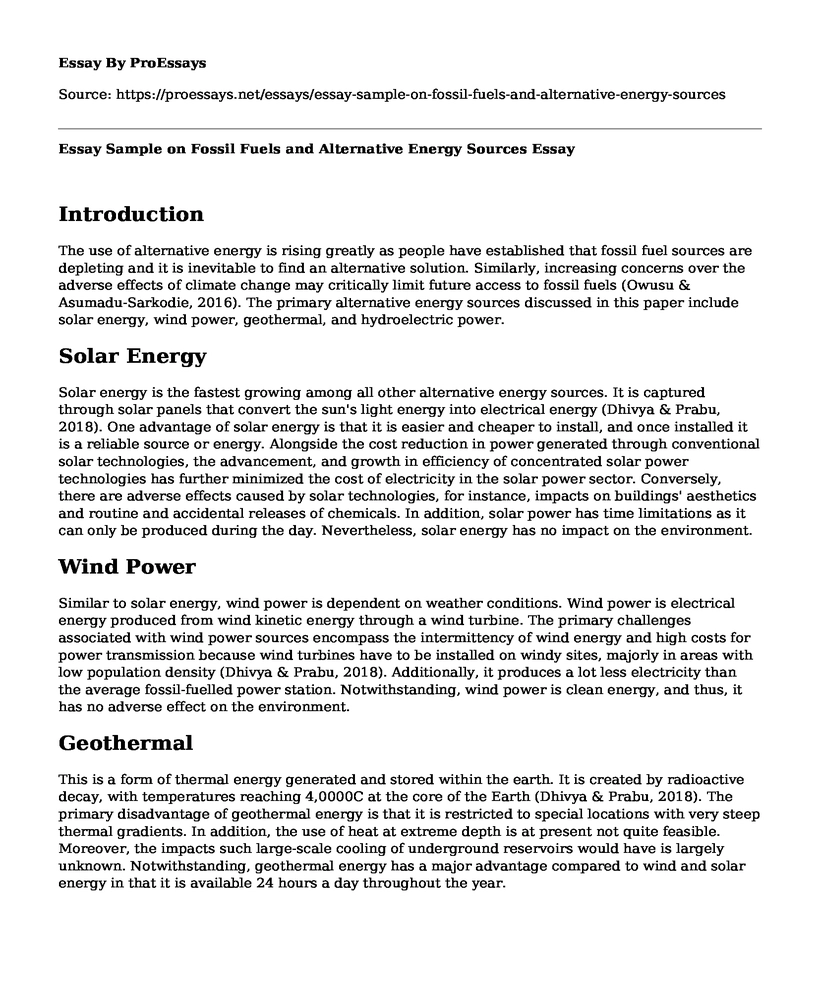Introduction
The use of alternative energy is rising greatly as people have established that fossil fuel sources are depleting and it is inevitable to find an alternative solution. Similarly, increasing concerns over the adverse effects of climate change may critically limit future access to fossil fuels (Owusu & Asumadu-Sarkodie, 2016). The primary alternative energy sources discussed in this paper include solar energy, wind power, geothermal, and hydroelectric power.
Solar Energy
Solar energy is the fastest growing among all other alternative energy sources. It is captured through solar panels that convert the sun's light energy into electrical energy (Dhivya & Prabu, 2018). One advantage of solar energy is that it is easier and cheaper to install, and once installed it is a reliable source or energy. Alongside the cost reduction in power generated through conventional solar technologies, the advancement, and growth in efficiency of concentrated solar power technologies has further minimized the cost of electricity in the solar power sector. Conversely, there are adverse effects caused by solar technologies, for instance, impacts on buildings' aesthetics and routine and accidental releases of chemicals. In addition, solar power has time limitations as it can only be produced during the day. Nevertheless, solar energy has no impact on the environment.
Wind Power
Similar to solar energy, wind power is dependent on weather conditions. Wind power is electrical energy produced from wind kinetic energy through a wind turbine. The primary challenges associated with wind power sources encompass the intermittency of wind energy and high costs for power transmission because wind turbines have to be installed on windy sites, majorly in areas with low population density (Dhivya & Prabu, 2018). Additionally, it produces a lot less electricity than the average fossil-fuelled power station. Notwithstanding, wind power is clean energy, and thus, it has no adverse effect on the environment.
Geothermal
This is a form of thermal energy generated and stored within the earth. It is created by radioactive decay, with temperatures reaching 4,0000C at the core of the Earth (Dhivya & Prabu, 2018). The primary disadvantage of geothermal energy is that it is restricted to special locations with very steep thermal gradients. In addition, the use of heat at extreme depth is at present not quite feasible. Moreover, the impacts such large-scale cooling of underground reservoirs would have is largely unknown. Notwithstanding, geothermal energy has a major advantage compared to wind and solar energy in that it is available 24 hours a day throughout the year.
Hydroelectric Power
This is electric energy generated through the gravitational force on the water. It is currently the largest renewable energy source for power generation around the world. The primary advantages of hydropower are that it is attractive because of a preexisting supply of water for agriculture, it is suitable for household and industrial use, it is clean, and it enables the storage of both water and energy. Additionally, the stored energy can be employed for the application of both base-load and peak time power generation (Owusu & Asumadu-Sarkodie, 2016). However, it is expensive to build, raises safety concerns especially about dam failures, and it leads to relocation of large populations to pave way for dam construction. The impact of hydropower on the environment is that the constructions of large engineering works lead to environmental degradation.
Recommendation
Based on this analysis, I would recommend the use of solar energy as the best approach. Solar panels are easy to install in homes. In addition, large scale solar harvesting can be located in areas that have sunlight almost throughout to ensure continuous supply of clean energy for home and industrial use.
Ways to Reduce Energy Use
The less the energy one uses, the less the adverse effect on the environment due to reduced greenhouse emissions. Personally, I can reduce energy use through the following three examples. First, I can reduce energy use by making the most of free heating and cooling. For example, during summer, I can shade window and use nighttime breezes to keep the home cool. Second, I can minimize energy use by making it a habit to turn off lights when I leave a room. Finally, switching off appliances instead of using standby power can help me decrease energy use.
References
Dhivya, B., & Prabu, V. (2018). A Review of Renewable Energy Supply and Energy Efficiency Technologies. International Research Journal of Automotive Technology, 1(6), 49-59.
Owusu, P. A., & Asumadu-Sarkodie, S. (2016). A review of renewable energy sources, sustainability issues and climate change mitigation. Cogent Engineering, 3(1), 1167990.
Cite this page
Essay Sample on Fossil Fuels and Alternative Energy Sources. (2022, Dec 13). Retrieved from https://proessays.net/essays/essay-sample-on-fossil-fuels-and-alternative-energy-sources
If you are the original author of this essay and no longer wish to have it published on the ProEssays website, please click below to request its removal:
- Essay Sample on Virtual Teams and Robotics
- The Uses and Significance of Quantum Mechanics in Nanotechnology - Paper Example
- Moroccans' Mobile Phone Use: Impact on Identity, Relationships and Environment - Essay Sample
- Essay Example on AI Transforming Tech: Revolutioanizing Industries
- Essay Example on Tech Advances Making Smartphone Shopping Easier and More Fun
- Free Paper Example on Cognitive Development: The Information Processing Approach
- Impacts of Emerging Technologies - Report Sample







